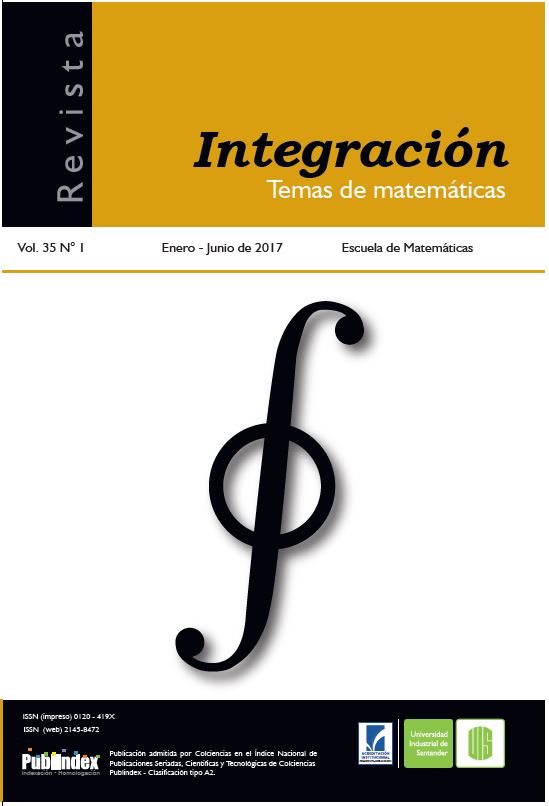Publicado 2017-08-09
Palabras clave
- Distribución Birnbaum-Saunders,
- distribución alfa potencia,
- distribución potencia t de Student
Cómo citar

Esta obra está bajo una licencia internacional Creative Commons Atribución 4.0.
Resumen
La distribución de probabilidad propuesta por Birnbaum y Saunders se ha usado con bastante eficacia para modelar tiempos de falla de materiales sujetos a la fátiga. En este artículo definimos una extensión de la distribución Birnbaum-Saunders clásica sustituyendo la distribución normal por la distribución potencia t de Student. La nueva distribución es más flexible que la distribución Birnbaum-Saunders clásica en términos de asimetría y curtosis. Presentamos los estimadores de máxima verosimilitud de los parámetros del modelo y su modelo de regresión asociado. El análisis de dos aplicaciones con datos reales revelan una superioridad del nuevo modelo con relación a otros modelos existentes en la literatura.
MSC2010: 62-07, 62F10, 62J02, 62N86.
Descargas
Referencias
[2] Berkane M., Kano Y. and Bentler P.M., “Pseudo maximum likelihood estimation in elliptical theory: effects of misspecification”, Comput. Statist. Data Anal. 18 (1994), No. 2, 255–267.
[3] Birnbaum Z.W. and Saunders S.C., “A new family of life distributions”, J. Appl. Probab. 6 (1969), 319–327.
[4] Castillo E. and Hadi A., “A method for estimating parameters and quantiles of distributions of continuous random variables”, Comput. Statist. Data Anal. 20 (1995), No. 4, 421–439.
[5] Castillo N.O., Gómez H.W. and Bolfarine H., “Epsilon Birnbaum-Saunders distribution family: properties and inference”, Statist. Papers 52 (2011), No. 4, 871–883.
[6] Cordeiro G.M. and Lemonte A.J., “The exponentiated generalized Birnbaum-Saunders distribution”, Appl. Math. Comput. 247 (2014), 762–779.
[7] Chan P.S., Ng H.K.T., Balakrishnan N. and Zhou Q., “Point and interval estimation for extreme-value regression model under Type-II censoring”, Comput. Statist. Data Anal. 52 (2008), No. 8, 4040–4058.
[8] Díaz-García J.A. and Leiva-Sánchez V., “A new family of life distributions based on the elliptically contoured distributions”, J. Statist. Plann. Inference 128 (2005), No. 2, 445–457.
[9] Durrans S.R., “Distributions of fractional order statistics in hydrology”, Water Resources Research 28 (1992), No. 6, 1649–1655.
[10] Fernández C. and Steel M., “Multivariate Student t regression models: Pitfalls and inference”, Biometrika 86 (1999), No. 1, 153–167.
[11] Gómez H., Olivares J. and Bolfarine H., “An extension of the generalized Birnbaum-Saunders distribution”, Statist. Probab. Lett. 79 (2009), 331–338.
[12] Gupta R.D. and Gupta R.C., “Analyzing skewed data by power normal model”, TEST 17 (2008), No. 1, 197–210.
[13] Lange K.L., Little R.J.A. and Taylor J.M.G., “Robust statistical modeling using the t distribution”, J. Amer. statist. Assoc. 84 (1989), No. 408, 881–896.
[14] Leiva V., Ponce G., Marchant C. and Bustos O., “Fatigue statistical distributions useful for modeling diameter and mortality of trees”, Rev. Colombiana Estadíst. 35 (2012), No. 3, 349–370.
[15] Lemonte A.J., “A log-Birnbaum-Saunders regression model with asymmetric errors”, J. Stat. Comput. Simul. 82 (2012), 1775–1787.
[16] Lemonte A.J., “A new extension of the Birnbaum-Saunders distribution”, Braz. J. Probab. Stat. 27 (2013), 133–149.
[17] McCool J.I., “Confidence limits for Weibull regression with censored data”, IEEE Trans. on Reliability 29 (1980), 145–150.
[18] Martínez-Flórez G., Bolfarine H. and Gómez H.W., “An alpha-power extension for the Birnbaum-Saunders distribution”, Statistics 48 (2014), No. 4, 896–912.
[19] Martínez-Flórez G., Bolfarine H. and Gómez H.W., “The log-linear Birnbaum-Saunders power model”, Methodol. Comput. Appl. Probab. (2016), 1–21.
[20] Moreno-Arenas G., Martínez-Flórez G. and Barrera-Causil C., “Proportional hazard Birnbaum-Saunders distribution with application to the survival data analysis”, Rev. Colombiana Estadíst. 39 (2016), No. 1, 129–147.
[21] Ng H., Kundu D. and Balakrishnan N., “Modified moment estimation for the two-parameter Birnbaum-Saunders distribution”, Comput. Statist. Data Anal. 43 (2003), No. 3, 283–298.
[22] Paula G., Leiva V., Barros M. and Liu S., “Robust statistical modeling using the Birnbaum-Saunders t distribution applied to insurance”, Appl. Stoch. Models Bus. Ind. 28 (2012), No. 1, 16–34.
[23] R Development Core Team, R: A Language and Environment for Statistical Computing, R Foundation for Statistical Computing, Vienna, Austria, 2015.
[24] Rieck J.R. and Nedelman J.R., “A log-linear model for the Birnbaum-Saunders distribution”, Technometrics 33 (1991), No. 1, 51–60.
[25] Saunders S.C., “A family of random variables closed under reciprocation”, J. Amer. Statist. Assoc. 69 (1974), No. 346, 533–539.
[26] Taylor J. and Verbyla A., “Joint modelling of location and scale parameters of the t distribution”, Stat. Model. 4 (2004), No. 2, 91–112.
[27] Vilca-Labra F. and Leiva-Sánchez V., “A new fatigue life model based on the family of skew-elliptical distributions”, Comm. Statist. Theory Methods 35 (2006), No. 2, 229–244.
[28] Vuong Q., “Likelihood ratio tests for model selection and non-nested hypotheses”, Econometrica 57 (1989), No. 2, 307–333.
